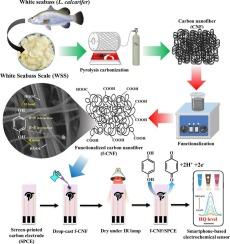A novel smartphone-based electrochemical hydroquinone sensor using renewable electrocatalyst of carboxyl-functionalized carbon nanofiber derived from white seabass scale collagen
IF 4.9
2区 化学
Q1 CHEMISTRY, ANALYTICAL
引用次数: 0
Abstract
A smartphone-assisted square wave voltametric hydroquinone (HQ) sensor was developed based on novel functionalized carbon nanofiber (f-CNF) derived from a sustainable precursor of white seabass (Lates calcarifer) scale collagen via slow pyrolysis carbonization. The as-prepared f-CNF exhibited a consistent fibrous structure with a large surface area, high graphitic content, high crystallinity, abundant carboxyl groups, and excellent dispersibility. The f-CNF was drop-cast on a screen-printed carbon electrode (f-CNF/SPCE). The proposed sensor exhibited high electrical conductivity, rapid electron transfer, a large electroactive surface area, a high number of adsorption sites, and outstanding electrocatalytic activity. The portable HQ sensor demonstrated a wide linear detection range from 1.0 to 150 μM (R2 = 0.9959) with a limit of detection (LOD) at 0.54 μM. Reproducibility and selectivity were excellent. The highlights of this electrochemical sensor are reusability for up to 18 cycles (90 individual measurements) and high stability for 8 weeks in use and 12 weeks in storage. The f-CNF/SPCE successfully detected HQ in pharmaceutical samples, achieving acceptable recoveries from 96.1 to 102.9 %. The results were consistent with those obtained using UV–Vis spectrophotometry and with product label information. Additionally, the square wave voltametric sensing application allows for the simultaneous detection of HQ, catechol (CC), and resorcinol (RS).

一种基于智能手机的新型对苯二酚电化学传感器,使用可再生电催化剂的羧基功能化碳纳米纤维来源于白鲈鱼鳞片胶原蛋白
基于新型功能化碳纳米纤维(f-CNF),开发了一种智能手机辅助方波伏安对苯二酚(HQ)传感器。该纳米纤维是由可持续的白鲈鱼(Lates calcarifer)鳞状胶原蛋白前体通过缓慢热解碳化而获得的。制备的f-CNF纤维结构一致,比表面积大,石墨含量高,结晶度高,羧基丰富,分散性好。将f-CNF滴铸在丝网印刷的碳电极(f-CNF/SPCE)上。该传感器具有高导电性、快速的电子转移、大的电活性表面积、大量的吸附位点和出色的电催化活性。便携式HQ传感器线性检测范围为1.0 ~ 150 μM (R2 = 0.9959),检出限为0.54 μM。重现性和选择性良好。这种电化学传感器的亮点是可重复使用长达18个周期(90个单独的测量)和8周使用和12周存储的高稳定性。f-CNF/SPCE成功地检测了药物样品中的HQ,回收率为96.1 ~ 102.9%。结果与紫外-可见分光光度法和产品标签信息一致。此外,方波伏安传感应用允许同时检测HQ,儿茶酚(CC)和间苯二酚(RS)。
本文章由计算机程序翻译,如有差异,请以英文原文为准。
求助全文
约1分钟内获得全文
求助全文
来源期刊

Microchemical Journal
化学-分析化学
CiteScore
8.70
自引率
8.30%
发文量
1131
审稿时长
1.9 months
期刊介绍:
The Microchemical Journal is a peer reviewed journal devoted to all aspects and phases of analytical chemistry and chemical analysis. The Microchemical Journal publishes articles which are at the forefront of modern analytical chemistry and cover innovations in the techniques to the finest possible limits. This includes fundamental aspects, instrumentation, new developments, innovative and novel methods and applications including environmental and clinical field.
Traditional classical analytical methods such as spectrophotometry and titrimetry as well as established instrumentation methods such as flame and graphite furnace atomic absorption spectrometry, gas chromatography, and modified glassy or carbon electrode electrochemical methods will be considered, provided they show significant improvements and novelty compared to the established methods.
 求助内容:
求助内容: 应助结果提醒方式:
应助结果提醒方式:


